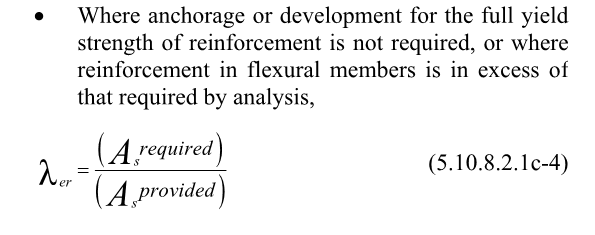Quade999
Civil/Environmental
- May 29, 2020
- 61
I am wondering on the applicability of the excess reinforcement factor in reducing development lengths.

From what I have seen, this factor is only applied if there is more steel than required by analysis at the ultimate limit states when the flexural capacity of a member is calculated where the reinforcement yields. But I am wondering if this applies for the serviceability limit state. Under service conditions the stress in the reinforcement is limited to 60% of the yield stress of the reinforcement. Does each state need to be analyzed separately to determine the area of steel required, and then the modification factor would be the worst case of the 2 scenarios? or is it based solely off the ultimate limit state? As it is possible to have a As required value that is larger under service conditions than that under ultimate conditions. The reason being that ULS is based on reinforcement capacity, while SLS is based on reinforcement modulus of elasticity to limit cracking and deflections.
Basically, does it make sense to apply this to SLS as well, even though we can't exceed 60% yield stress under service conditions? Or can it be said that if you replace fy in the development length calculation with 0.6fy and this much anchorage is provided, then you don't need to consider an excess reinforcement modification factor here?
Thanks

From what I have seen, this factor is only applied if there is more steel than required by analysis at the ultimate limit states when the flexural capacity of a member is calculated where the reinforcement yields. But I am wondering if this applies for the serviceability limit state. Under service conditions the stress in the reinforcement is limited to 60% of the yield stress of the reinforcement. Does each state need to be analyzed separately to determine the area of steel required, and then the modification factor would be the worst case of the 2 scenarios? or is it based solely off the ultimate limit state? As it is possible to have a As required value that is larger under service conditions than that under ultimate conditions. The reason being that ULS is based on reinforcement capacity, while SLS is based on reinforcement modulus of elasticity to limit cracking and deflections.
Basically, does it make sense to apply this to SLS as well, even though we can't exceed 60% yield stress under service conditions? Or can it be said that if you replace fy in the development length calculation with 0.6fy and this much anchorage is provided, then you don't need to consider an excess reinforcement modification factor here?
Thanks
